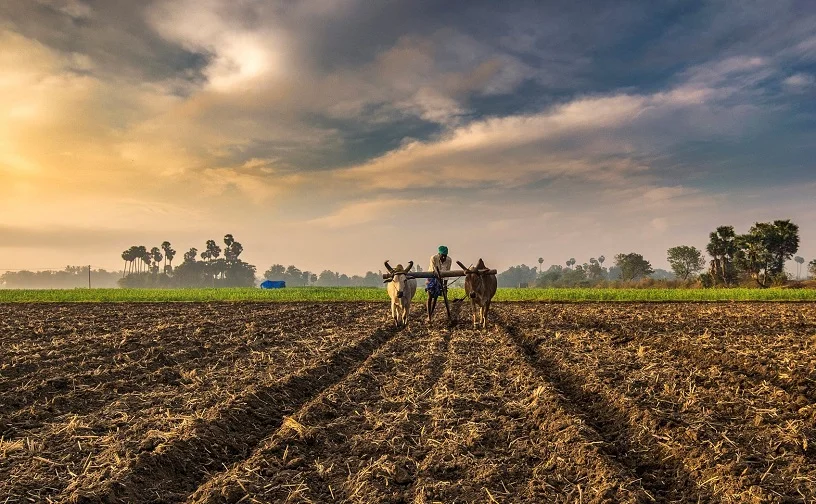
A more holistic and pragmatic approach needs to be adopted by the policy makers to make Indian agriculture sector more competitive and profitable
By Asad Mirza
SINCE Independence agriculture sector has remained the main source of national income and occupation in India. In 1947, 72 per cent of the total working population was engaged in agricultural sector, but still a majority of India’s poor (some 770 million people or about 70 per cent) inhabit the rural areas.
Though due to the high growth rates of the industrial and services sectors, the share of agricultural share in India’s economy has progressively declined to less than 15%, yet its importance in India’s economic and social development can’t be denied.
On road to self-sufficiency
The Green revolution of 1960s witnessed a drastic increase in total agricultural production, particularly wheat and rice. The second phase of the Green revolution further boosted it in 1980s, which was accelerated further by the liberalisation policy of the late 1990s.
However, the results of the Green revolution were not uniform over the entire country. It particularly resulted in enhanced cultivation and production of wheat and rice in the northern states, and other cash crops such as cotton and onion in the western and southern states. But it neglected the cultivation of pulses and other cereals.
Though, India is considered to be a global agricultural powerhouse, yet the sector suffers from serious maladies. According a World Bank report of 2010, India is the world’s largest producer of milk, pulses, and spices, and has the world’s largest cattle herd (buffaloes), as well as the largest area under wheat, rice and cotton. It is the second largest producer of rice, wheat, cotton, sugarcane, farmed fish, sheep & goat meat, fruit, vegetables and tea. But in spite of this the Indian farmer remains poor, though he contributes a lot to the economy.
As per experts’ opinion the factors which contribute to the poor performance of the Indian agricultural sector are multi-dimensional, such as: poor access to reliable and timely market information to the farmers, absence of supply and demand forecasting, poorly structured and inefficient supply chains, inadequate cold storage facilities and shortage of proper food processing units, large intermediation between the farmers and the consumers, besides regional disparities are some of the major causes of the losses for the farmers.
The WB report lists that one of the biggest issues facing the agricultural sector in India is low yield: India’s farm yield is 30-50% lower than that of developed nations. Average farm size, poor infrastructure, low use of farm technologies and better farming techniques, decrease in soil fertility due to over fertilisation and sustained pesticide use, are leading contributors to low agricultural productivity.
Thus, measures to increase productivity will need increasing yields, diversification to higher value crops, and developing value chains to reduce marketing costs.
The sharp rise in food-grain production during India’s Green revolution of the 1970s enabled the country to achieve self-sufficiency in food-grains and stave off the threat of famine. Agricultural intensification in the 1970s to 1980s saw an increased demand for rural labour that raised rural wages and, together with declining food prices, reduced rural poverty. However agricultural growth in the 1990s and 2000s slowed down, averaging about 3.5% per annum, and cereal yields have increased by only 1.4% per annum in the 2000s. The slow-down in agricultural growth has become a major cause for concern. India’s rice yields are one-third of China’s and about half of those in Vietnam and Indonesia. The same is true for most other agricultural commodities.
Reforming the sector
What we need is a pragmatic, realistic and holistic approach to be adopted by the policy makers to address the maladies faced by the Indian agriculturists. Besides resolving the regional disparities in crop patterns, the government also needs to promote cultivation and change in eating habits of the populace. One route to this could be propagating the inclusion of millets and other high nutritious cereals, in the eating habits of the populace. This besides increasing the earning potential of the farmers in the drought prone or less irrigated areas will also result in making better use of the cultivable area across the country.
Further action in this regard could be taken by the government by supporting and collaborating with international institutions like International Crops Research Institute for the Semi-Arid Tropics (ICRISAT), which are engaged in popularising the cultivation and use of highly nutritious crops like millet and sorghum.
Icrisat, as per its mandate strives to be the change catalyst through a partnership approach to help rural communities develop their own solutions and engages with them to bring the vision to reality. Its inclusive approach ensures participation of women and youth, a must in finding sustainable and profitable solutions, besides contributing to several of the UN SDGs.
As Icrisat’s research area focuses on the drylands, it has an extra specialisation on crops that survive in these harsh climates, such as Chickpea and Groundnut, besides nutri-cereals like Sorghum, Pearl millet and Finger millet. Most of these crops besides being highly nutritious are also good for the planet as they have a low water footprint, lowers the carbon footprint, are good for the soils, use fewer chemicals, etc. Further they are good for the small farmer as they survive in the harshest climates, have multiple uses, have potential to significantly increase yield and cater to an untapped usage and demand.
Last month, the UN General Assembly unanimously declared 2023 as the International Year of Millets, the resolution for which was sponsored by India. PM Modi while endorsing this announcement expressed gratitude to all the nations, which initiated and co-sponsored this resolution. In a tweet, he said that India is honoured to be at the forefront of popularising Millets, whose consumption furthers nutrition, food security and welfare of farmers.
Both the cultivation and usage of these cereals and grain legumes could be achieved by focused efforts initially to popularise these smart foods to bring them into mainstream food habits. The strategy adopted to achieve this should involve and ensure that small farmers and rural communities benefit by receiving on-farm support, connecting farmers to value chains, linking smart food with health activities on the ground, and advocacy for policy support, research and development.
Policy makers will thus need to initiate and accomplish policy actions and public programmes to shift the agricultural sector away from the existing policy and institutional regime that appears to be no longer viable and build a solid foundation for a much more productive, internationally competitive, and diversified agricultural sector in the country. In addition, we’ll have to promote increased cultivation of those crops, which besides being nutritious and profitable are also able to counter the environmental challenges.
Views expressed in the article are the author’s own and do not necessarily represent the editorial stance of Kashmir Observer
- Asad Mirza is a political commentator based in New Delhi. Earlier he was associated with BBC Urdu Service and Khaleej Times of Dubai. He writes on Indian Muslims, educational, international, interfaith and current affairs. Email: asad.mirza.nd@gmail.com
Follow this link to join our WhatsApp group: Join Now
Be Part of Quality Journalism |
Quality journalism takes a lot of time, money and hard work to produce and despite all the hardships we still do it. Our reporters and editors are working overtime in Kashmir and beyond to cover what you care about, break big stories, and expose injustices that can change lives. Today more people are reading Kashmir Observer than ever, but only a handful are paying while advertising revenues are falling fast. |
| ACT NOW |
| MONTHLY | Rs 100 | |
| YEARLY | Rs 1000 | |
| LIFETIME | Rs 10000 | |












